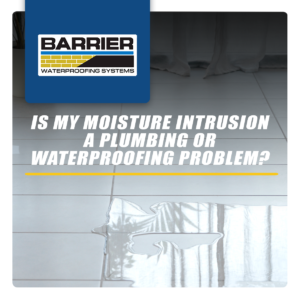Is Water Intrusion from a Plumbing Problem or a Waterproofing Problem? | BARRIER
Posted in: Industry News
 Water infiltration inside a home is a major problem that must be resolved immediately. There are several variables and causes that might contribute to water leakage, including cracked walls, corroded waterproofing, leaking AC units, plumbing leaks, corrosion, and more. In short, both a plumbing problem and a waterproofing problem can cause moisture intrusion to occur in your home.
Water infiltration inside a home is a major problem that must be resolved immediately. There are several variables and causes that might contribute to water leakage, including cracked walls, corroded waterproofing, leaking AC units, plumbing leaks, corrosion, and more. In short, both a plumbing problem and a waterproofing problem can cause moisture intrusion to occur in your home.
Water leaks within the home will always have negative effects on your home. Some of these include musty odors, the development of microorganisms, bug infestations, damaged goods, and many more. Therefore, although the house needs a complete health checkup to determine the true source of the moisture intrusion, here is a summary of likely candidates for causing those pesky water problems.
The potential sources of water infiltration might be very different, but because of how buildings are constructed they typically fit into well-known categories. One of the most frequent variables is a leak in your roofing system or ceiling, for example. These are typically brought on by some weakness in the roof itself.
Another frequent reason for moisture encroachment in many homes is a water line break or sewage backup, particularly if such systems have aged considerably. When they malfunction, fire sprinkler systems requiring plumbing may also produce leaks, which can swiftly result in serious damage to both the room’s ceiling and the room itself.
It doesn’t take much for a little flaw to grow and allow a sizable amount of flooding; moisture can also enter your home from the outside through basement walls or the floor. The overflowing of surrounding streams and rivers, snowmelt, intense rainfall, and localized flooding are just a few examples of natural meteorological conditions that most oftentimes turn into significant sources of water intrusion!
How Do I Know My Home Is Being Damaged By Moisture Intrusion?
Water can be dispersed through your home by way of leaks, harming your house and promoting unwelcome organic development. You might not always be aware that a leak has developed, especially since much of the plumbing in your home is hidden from view.
Understanding and searching for typical symptoms that lead to leaks are one of the most effective strategies to safeguard your property from future leaks (as well as repair damage before it spreads!). There are some typical indications of water leakage:
- Spots of darkness on the ceiling and walls
- A stale, musty smell or persistent musty odors
- Paint flaking off and plaster crumbling
- Arrival of pests
- Watermarks and color changes
- Moist masonry
- Mildew or mold growth
- Drips from the roof or puddles on the floor near the walls
How Do I Identify and Stop The Water Intrusion?
The most accurate, efficient, and safest way of identifying the sources or causes of moisture intrusion happening in your home is to call in to some local professional waterproofing services, like your team here at BARRIER Waterproofing Systems. Our team of experts will draw off of their years of experience to detect the symptoms and follow them to the source of the problem.
Most often, the following causes for moisture intrusion are identified and repaired in a timely manner!
.
Interior Plumbing Failure
If you discover your water leak within the wall, it may mean that your problem goes beyond a straightforward plumbing fix. Typically, the wall would be taken apart, the leak would be located precisely, and the damage repaired. Then, to restore the wall, sanding, priming, and painting the repaired wall would be done.
Leaking Basement Walls
A complete waterproofing solution may be required for your foundational walls. If moisture is intruding from cracks created by too much pressure, seeping up through the concrete, or a number of other reasons, waterproofing will solve it. Some houses restrict waterproofing from being put on one or more external walls because of roads, decks, patios, or neighboring houses. In these situations, the system can be relocated inside by trenching the floor, setting up floor drains, and building a sump pump system to redirect the water after it has entered.
Why is Waterproofing Required?
It should be clear that water infiltration can develop conditions that have the ability to seriously damage your home and could cause harm to those inside. Acting on your concern about these possibilities to take preventative maintenance measures may shield your home from these consequences.
There is also a chance that legal action might be taken in situations where an office building has been the target of infiltration if the structure was used to house expensive equipment. In any case, preventing water from entering your house or place of business is ideal. It is something that everyone should be concerned about to some level – even if you live in a relatively dry location.
Conclusion
A soggy setting makes for an uncomfortable home environment. However, due to dangers of causing structural instability and more, water leaks or seepage within the home should be located and fixed as soon as possible.
For more information about our professional waterproofing services for your basement or crawl space, give BARRIER Waterproofing Systems a call at (615) 257-1060 | (931) 536-1168. Call and schedule a FREE evaluation of your home’s foundation for our team to identify the source of the problem and discuss with you the best solutions to get the job done right.
Return to: Is Water Intrusion from a Plumbing Problem or a Waterproofing Problem? | BARRIER
Social Web